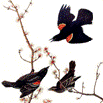Center, Internet, Wildlife Damage Management

Bird Control Seminars Proceedings
Document Type
Article
Date of this Version
10-1983
Citation
Proceedings Ninth Bird Control Seminar, Bowling Green State University, Bowling Green, Ohio, October 4-6, 1983. Ed. William B. Jackson and Beth Jackson Dodd
Abstract
The distribution and magnitude of blackbird/starling depredations were investigated at 287 randomly selected livestock farms inspected once and 24 farms repeatedly in· spected throughout the damage season in six selected livestock producing counties in Tennessee. Of those inspected once, 25.8% were categorized as having more than a negligible problem, including 6.3% with significant damage problems. Data on farms repeatedly inspected suggested that some damage was only intermittent, while others were sustained throughout the damage season. Starlings were the overall principal species involved in the damage problem, as well as being the species involved with the more significant and sustained problems. Although damage was widespread, an economic appraisal of damage levels suggested that significant economic losses were relatively isolated. An opinion poll of livestock producers interviewed further suggested that damage problems, particularly feed loss, is of concern to the majority of these producers; and almost half had used one or more methods to control birds.


Comments
Copyright (c) 1983 James F. Glahn